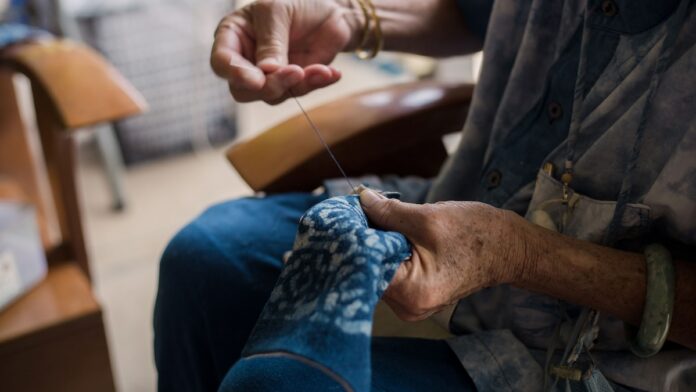This article was produced by National Geographic Traveller (UK).
“When I was small, it was all very traditional,” muses 69-year-old Prapapan Sritrai as she shows me around her workspace, where huge vats of bubbling, inky-blue liquid are being stirred by her husband. Auntie Ngeam, as she’s known locally, is one of a third generation of indigo artisans in a family descended from the Phuan, a people known for their handwoven fabrics. A sizeable Phuan community, originally from Laos, settled in Phrae, in northern Thailand, after being displaced from their homeland when the borders of Siam were expanded in the late 19th century, bringing their indigo craftsmanship with them. Auntie Ngeam’s Tardis-like indigo studio is located down a slim alley in Ban Thung Hong, a village on the outskirts of Phrae, almost equidistant between Chiang Mai and the Laos border. Here, where the green rolling hills are dissected by the Yom River and its tributaries, the acanthus and indigofera tinctoria plants central to indigo production flourish. Indigo — and, specifically, the production of dark-blue mo hom shirts, a common uniform for rural and agricultural workers in Thailand — became a key industry in Phrae after the demise of the local teak industry following the Second World War.
Auntie Ngeam inherited a small mo hom operation from her parents more than 30 years ago and has played a key role in updating Thailand’s indigo clothing over the past decade. “Every shop on the street had plain mo hom denim shirts, so I started thinking about how we could stand out,” she says. “I tried using the indigo to tie-dye modern clothes.” Now a common sight in Thai markets across the country, the tie-dyed garments that Auntie Ngeam pioneered have become a phenomenon.
Indigo has also brought tourism directly to Phrae. The town’s gingerbread-style teak houses act as a reminder of the wealth that flowed through here in the 1880s, when Phrae was the global epicentre of the teak industry. As well as taking apprentices in droves, Auntie Ngeam collaborates with the local government to promote local indigo via tie-dye workshops for tourists. And, for the past six years, the town has also hosted the Phrae Craft festival, a weekend event of markets and catwalk displays showcasing small, independent indigo artisans. The festival is run by Nanthanit Boyd, a former apprentice of Auntie Ngeam’s, who I meet at the latter’s workshop. As well as running Phrae Craft, Boyd has her own haute-couture indigo fashion line, Natcharal, which she launched in 2016. Today, it’s pushing the boundaries of indigo textile fashion, bringing Phrae designs to Bangkok catwalks. “Phrae is a very peaceful town, but we have artisanal events and creative showcases all year round,” says Boyd.
She takes me to the workshop of Passakorn Sangdoung Khamsam, who runs his Nat Craft indigo clothing brand from Phrae. He’s a tall chap with indigo-stained hands and is slightly flustered, having just returned from playing a volleyball match for the Thai national team in Cambodia. Passakorn tells me he previously worked as a civil servant for Phrae’s council but moved into the indigo industry in 2020 on the suggestion of Auntie Ngaem — and with the encouragement of his parents, who are weavers and master crocheters in their own right. When he’s not playing volleyball, Passakorn designs catwalk lines, too, using textures influenced by his family’s textile background. “Everything is made with love,” he says with a smile, adding that his family often work alongside him to craft his wares.
Intergenerational indigo businesses are ubiquitous in Phrae. My next stop is Banmatjai Indigo Workshop, which was opened by the women of the Suchanok family 10 years ago, when eldest daughter Chidchanok Suchanok returned home after graduating in design from Chiang Mai University. “I wondered why my generation wasn’t adapting and appreciating indigo,” she says. “It’s our Phuan heritage and a local resource.” Today, alongside her younger sister Chadanoot and their seamstress mother Amonpun, she runs one of the most successful workshop spaces in Phrae. It’s a peaceful, leafy place with an indigo tie-dyeing area, a pottery studio where Chadanoot runs ceramics sessions, a coffee shop and a small boutique where the trio sell their beautifully cut clothes. They see it as their mission to assist others on their own artisan path. “We like to help people who are coming back to their hometown of Phrae and wanting to work in indigo,” says Chidchanok. “It’s bringing more jobs to locals.” Since the Covid-19 pandemic, an increasing number of townspeople have returned to Phrae, disillusioned with Bangkok life and looking for more fulfilling, creative work closer to home. And as a new generation accepts the indigo mantle, Phrae has been reborn as a craft hub, creating employment through small-scale manufacturing and by encouraging both domestic and international travellers to this quiet corner of Thailand. “The creativity is already here, all you have to do is make it shine brighter so people can see it,” says Boyd, joining me for lunch before I leave town. “Some people think we need a big flashy tourist attraction in Phrae, but I think differently. We don’t need that. We’re already cool.”
Absolutely Fantastic Holidays can organise tailor-made seven-day itineraries to Phrae and Na from 91,000 TH (£2,013) per person, including six nights’ accommodation, B&B, with a private guide and transport, workshops and admission fees, but excluding flights. Phrae Craft festival takes place on 2-4 December 2023.
To subscribe to National Geographic Traveller (UK) magazine click here. (Available in select countries only).



